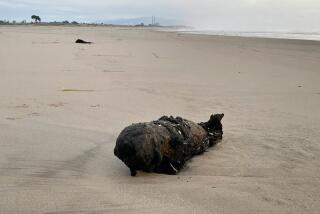Blimp Pilot Remembers Tustin Base’s Heyday
- Share via
His was a war spent floating off the Southern California coast, watching and waiting for an ominous blip on the radar screen that, thankfully, never came.
As World War II raged an ocean away, Willard Brown was one of about 50 blimp pilots stationed at the former Santa Ana Naval Air Station, now named the Tustin Marine Corps Air Facility.
Armed with powerful machine guns and underwater explosives, their mission was to patrol the coast in search of enemy submarines.
Today, those blimps are historical afterthoughts, long-since retired and seen only in old snapshots or film footage.
Brown, 80, of Palm Springs, was studying for a pilot’s license in Santa Barbara when WWII broke out. “We joined up very much so as to be patriotic,” he says.
There weren’t enough planes to go around, so Brown elected instead to try his hand at blimps, and joined the Navy’s Lighter-Than-Air ranks.
He was one of 12 ensigns who arrived at Tustin in 1942, the first squadron stationed there. It would be months before one of the base’s famous hangars were completed, so pilots took turns watching the blimps overnight to ensure that they were not torn from their outdoor moorings.
The blimps were retired from military service during the 1950s. Some were sold for advertising, others destroyed. A few were preserved as artifacts.
Piloting blimps was not without peril. During Tustin’s history, one blimp crashed on Santa Catalina Island. Another exploded while landing.
Blimp pilots take pride in their wartime role, even though no submarine was ever detected off the West Coast. Brown points out that no ship protected by a blimp was ever sunk, either.
“The fear was we would lose ships, and we would lose men,” Brown says. “We were out there to keep them from that. We did that.”
More to Read
Sign up for Essential California
The most important California stories and recommendations in your inbox every morning.
You may occasionally receive promotional content from the Los Angeles Times.













